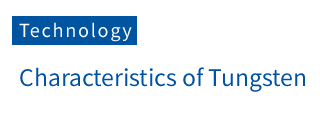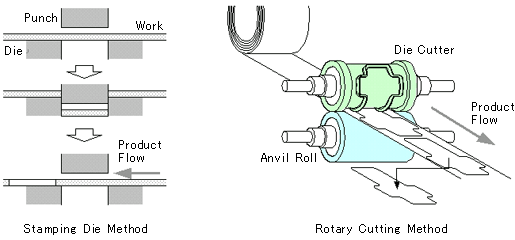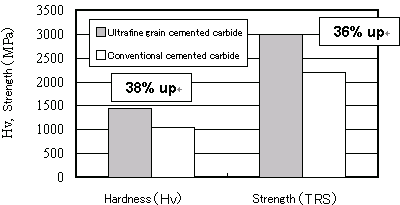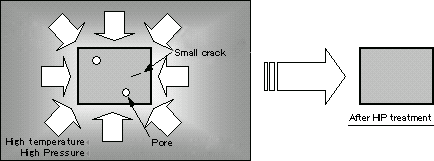
NT Die Cutter" is a carbide rotary cutter which cuts contours of various products such as non-woven fabrics or paper that is difficult to proceed with stamping die method at high speed and in high precision. Rotary cutter consists of a die cutter, which has three-dimensional cutter blades on the cylindrical outer surface, and an anvil roll, which has a smooth cylindrical outer surface, and raw material sheets are cut into the required product shape by passing those two rolls. The conventional die cutter is made of tool steel, but it had a disadvantage in product-life cycle due to abrasion.
In order to dissolve this problem, we first applied our original cemented carbides and machining technologies to die cutters. Herewith, the product-life cycle of NT Die Cutter can last about 10 times longer than conventional tool steel die cutter. Moreover, the high-speed operation, excellent cutting ability, and high reliability could be obtained (A patent has been acquired).
After commercialization of the NT Die Cutter, we have continuously improved it to respond to customers' needs. Therefore, it has been accepted by many domestic and foreign customers. From now on, we will be providing NT Die Cutter with high quality as the world brand of Carbide rotary cutter from the ISO9001 (2000) certified factory.
NT Die Cutter is created for our unique material technology and machining technology. Therefore, it is possible to cut at an operation speed about 10 times faster than stamping die method (converted into the operation speed, it becomes 300m/min or more). The reasons are as follows: (1) High knife-edge stress can be generated by the high Young's (2) The conventional stamping die method is discontinuous (e.g.work setting, punch/exhaust, work transfer) against the work flow, but rotary cutting method is continuous (Figure 1).

Material properties required as the rotary die cutter are (1) long product life cycle (wearing resistance), (2) high reliability (chipping resistance), and (3) excellent cutting ability. To satisfy those requirescemented carbide should be harder and tougher. Accordingly, our original ultrafine grain cemented carbide is applied to the NT Die Cutter. Ultrafine grain cemented carbide is made of the WC (Tungsten carbide), as a hard particle, which refined mean grain size to less than 1 micron in order to achieve both higher hardness and strength in comparison with the conventional one(Figure 2). In addition, the finer mean grain size, the shaper cutting edge is obtained (Figure 3, patent pending).

NT Die Cutter based on our powder metallurgical technology, which allows us to make the complicated products shapes by sintering raw material powders. The manufacturing process is roughly classified as the powder mixing process to sintering, HIP (Hot Isostatic Pressing) and the machining process.
In the sintering process, our original powder metallurgical technology is applied to obtain both high material property and stable quality. Specially, HIP (Figure 4) is a special process to ultimately depress material defects, such as remained pores (vacancies) and small cracks, with treating under high temperature and high pressure. Therefore, HIP-treated carbides can be brought out its material-essential high performance.
We can offer the appropriate material design and mechanical design to meet every customer's needs. For the material design, the appropriate cemented carbide material combination is designed according to the driving method and the work, Also, for the mechanical design, the appropriate knife-edge pattern and shape is designed according to the FEM analytic result (patent pending).
Also, We designed three carbide assembling method, sleeve type, separate type, and segment type, to enhance cost performance with using expensive carbide effectively (Figure 5).



In the sanitary products industry, the production speed has kept being improved. At present, due to efforts for improvement in the converter-line manufactures, the production line speed has become over 300m/min. Due to realize such high speed processing highly rigid flame unit with loading system and excellent cutting performance are required. In addition, at the 24 hours continuous operation, the long tool life and high reliability are required for the die cutter to reduce tool change. NT Die Cutter has realized the customer's requests through utilizing its cemented carbide property.
NT Die Cutter not only achieves the high speed processing but also saves running cost and maintenance time. Therefore, NT Die Cutter is highly valued in this business field.
Recently, since small and thin electric devices are demanded, the metal foil less than 10 microns is utilized in the industries. To cut those foils by stamping die, extremely precise clearance is required. Generally, it is known that the clearance should be 3-12%(1)of the work thickness is required, then, in case of 10 micros thickness work, its clearance should be about 1 micron. However, because stamping die having such narrow clearance is hardly produced commercially, It can be said that stamping die method for such thin metal foil is difficult. 0n the other hand., Since there is no problem concerning the clearance in the rotary cutting method die cutter can have high cutting at high speed.
In addition, the zero rim, which method has no trim space in the web for direction, is easy to realize by utilizing rotary cutting method. That is effective in raw material cost reduction. Therefore, it is a very interesting cutting method for the customer using expensive materials.
Also, in the case of cutting hard metal material by the conventional steel die cutter the tool life is excessively shorter than that of non-woven fabric cutting. Therefore, the need of carbide die cutter come to increase recently.
On one hand the customers who have already used the steel die cutter are attracted to the performance of the carbide die cutter, such as long life, low maintenance frequency applicability for the hard cutting materials, etc. On the other hand the customers who haven't used die cutter are attracted to the performance of rotary cutting method itself, such as the quality of cut surface, complex contour cut, etc. We have been receiving a lot of inquires and requests through our homepage.
We work actively for sales and technical service to respond customer's needs. Also, the research and development are done to cultivate our material and machining technologies further, and we focus on prompt commercialization of new technologies and new materials.
In case of cutting the highly ductile material such as metal or resins by using rotary cutter, the burr at the cutting part sometimes come to be a problem. This burr is generated by crushing a material by the top flat area on the knife-edge. Therefore, while it is possible to prevent from the Generation of burr by eliminating the flat area on Knife-edge, at the same time the other problems such as high frequency of chipping may be occurred.
We basically researched cutting mechanism of metal on rotary cutting method, and obtained the knowledge of the burr generation mechanism. From this product of basic research, the die cutter to enable to satisfy both control of burr generation and high cutting was developed (patent pending). We have been applying this technology to the die cutter for metal foil cutting application, and receive high evaluation from customers.
| Item | Specificattions | |||
|---|---|---|---|---|
| Work size (Cutting area size) |
Max. 1,100×400mm(Sleeve type*1) (Max. size of carbide part:ODφ360×1,500mm) Max. 1,600×1,000mm(Separate type*2) (Max. size of carbide part:ODφ500×14500mm) |
|||
| Mterial of die cutter | Ultrafine grain cemented carbide FND30 (HRA=90) | |||
| Material of anvil roll | Ultrafine of fine grain cemented carbide or dice steel *3 | |||
| Product shape (Pattern of knife-edge) |
Radius | R0.1mm and more Recommended value : R10 or more (on development drawing) |
||
| Spacing between blades | 5mm or more (on development drawing) |
|||
| Joined pattern |
|
|||
| Blade apex angle | According to requirement | |||
| Thickness of carbide | Standard value : 10mm (Min. 8mm) | |||
| Vacuum hole |
|
|||
| Manifold | Installation of manifold for suction and blowing is available. | |||
| Driving method | Die cutter : driven Anvil roll : Gear driven or free (driven by friction) |
|||
| Loading method | Pneumatic or Hydraulic or Mechanical loading | |||
| Flame unit | According to requirement | |||
| Other | For further information, please feel free to contact us. | |||